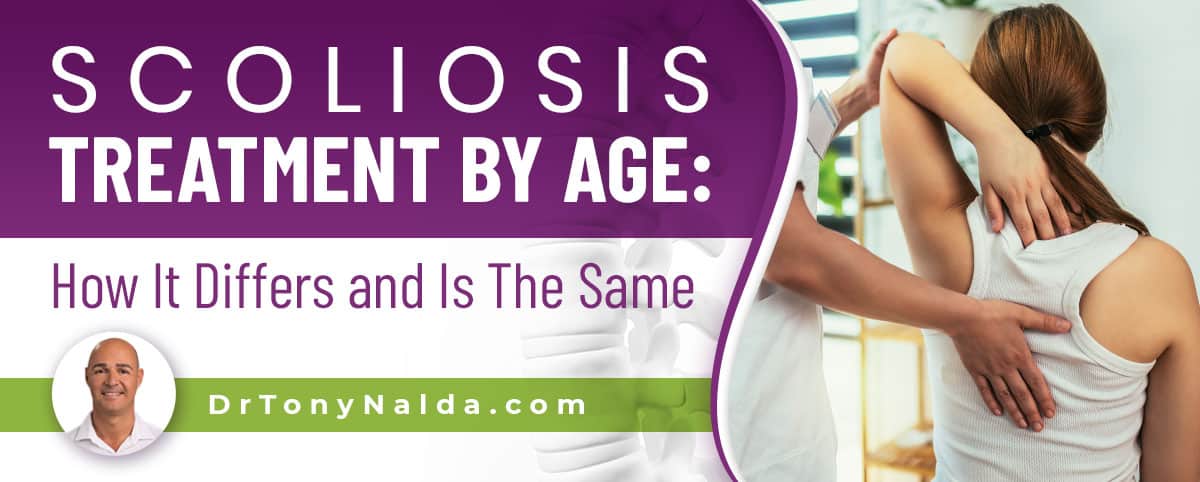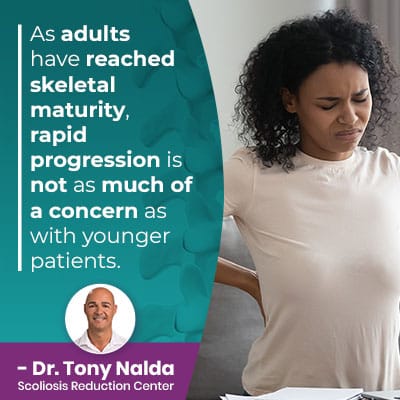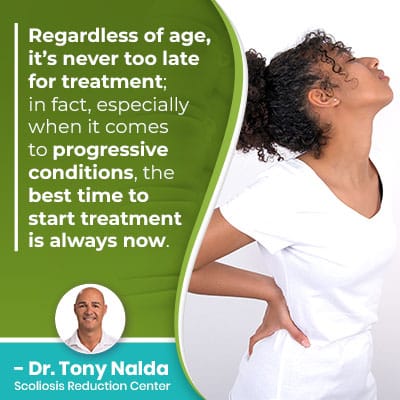Scoliosis Treatment by Age: How It Differs and Is The Same

While most people think of scoliosis as an adolescent condition, it affects all ages. Part of the diagnostic process involves comprehensive assessment in order to classify the condition based on key patient/condition variables. Patient age is a classification point and an important variable that factors into treatment needs.
Scoliosis is a highly-variable condition that can range from mild to very severe. While its most common form is adolescent idiopathic scoliosis, it can affect all ages, from infants to the elderly. The diagnostic process is similar for different ages, but treatment needs will vary.
Before exploring the differences and similarities of scoliosis treatment in different ages, let’s first talk generally about the condition.
Table of Contents
Scoliosis
Being diagnosed with scoliosis means an unnatural sideways spinal curve, with rotation, has developed and has a Cobb angle measurement of at least 10 degrees.
Cobb angle is a measurement taken during X-ray that tells me how far out of alignment a scoliotic spine is; lines are drawn from the tops and bottoms of the most-tilted vertebrae at the apex of the curve.
The intersecting lines form an angle that’s expressed in degrees and places conditions on a wide severity scale:
- Mild scoliosis: Cobb angle measurement of between 10 and 25 degrees
- Moderate scoliosis: Cobb angle measurement of between 25 and 40 degrees
- Severe scoliosis: Cobb angle measurement of 40+ degrees
- Very-severe scoliosis: Cobb angle measurement of 80+ degrees
As you can tell from the wide range of numbers, scoliosis is a highly-variable condition, which is why no two cases will be the same, and treatment plans have to be fully customized to address specific patient/condition variables.
As a progressive condition, it also has it in its nature to worsen over time, particularly if left untreated or not treated proactively; mild scoliosis can easily become moderate, severe, or very severe if not treated proactively.
Patient age is an important condition variable that shapes the design of effective treatment plans, so let’s touch on the different age categories of scoliosis patients, starting with infant scoliosis.
Infant Scoliosis Treatment
Infants born with scoliosis have congenital scoliosis, caused by a malformation in the spine itself that develops in utero.
Cases of congenital scoliosis are rare, affecting approximately 1 in 10,000, and can involve a vertebra (bone of the spine) being malformed, causing a misaligned spine to develop.
Congenital scoliosis can also develop as multiple vertebrae fail to separate and develop as distinct spinal bones, instead becoming fused together (bony bar).
Infants from 0 to 3 years old with scoliosis are unique patients to treat due to their young age; treatment plans for infants will involve modification from my approach used with older children and teens.
Modified scoliosis-specific therapy and corrective bracing are commonly the most effective forms of treatment for this age group, depending on condition severity.
From infant scoliosis, the next age group is classified as child scoliosis.
Child Scoliosis Treatment
 Child scoliosis refers to children between the ages of 3 and 10, and typically, this is the age group that’s most responsive to treatment for the best long-term results.
Child scoliosis refers to children between the ages of 3 and 10, and typically, this is the age group that’s most responsive to treatment for the best long-term results.
However, for those on the path of traditional treatment, this is also the time that patients are told to simply watch and wait: an approach I caution against because, as a progressive condition, merely observing means allowing scoliosis to progress unimpeded.
For this age group, depending on the curve and maturity of the patient, all my treatment methods can be applied to manage progression, reduce scoliosis on a structural level, and prevent the need for invasive treatment in the future.
Treatment for this age group would involve condition-specific chiropractic care, in-office therapy, custom-prescribed home exercises, and corrective bracing.
The next age group we’re talking about is teenager scoliosis.
Teenager Scoliosis Treatment
When it comes to teenagers with scoliosis, we’re talking about the most prevalent form of scoliosis: adolescent idiopathic scoliosis (AIS), diagnosed between the ages of 10 and 18.
The majority of patients are diagnosed during this age because this is when the condition tends to become noticeable due to growth.
The most common signs of adolescent idiopathic scoliosis are postural changes like uneven shoulders, hips, an uneven waistline, the development of a rib arch, and changes to gait.
Changes to balance, coordination and ill-fitting clothing are also signs of the condition.
While the idiopathic designation means we don’t know why the condition developed initially, we do know what triggers its progression: growth and development.
Considering the stage of puberty these patients are in, or entering into, at the time of diagnosis, they are at risk for rapid-phase progression.
As growth spurts can be rapid and unpredictable during this stage, treatment plans need to be fully customized and adapted as needed; I observe how the spine responds to treatment and growth and adjust treatment plans accordingly.
Teenagers can use all of my treatment modalities to help either hold their scoliosis where it is throughout growth (counteracting its progressive nature) or reduce the curvature further, so the condition is impacted on a structural level.
Through chiropractic adjustments, I can work towards impacting the condition on a structural level by manipulating the position of the curve’s most-tilted vertebrae back into alignment with the rest of the spine.
Corrective bracing, like the ScoliBrace, can be particularly effective at augmenting correction in growing spines, and when combined with other forms of treatment like in-office therapy and scoliosis-specific exercises, there are fewer limits to what we can achieve.
Now, we’re moving on to adult scoliosis.
Adult Scoliosis Treatment
The two types of scoliosis that are most common in adults are idiopathic and degenerative.
As adults have reached skeletal maturity, rapid progression is not as much of a concern as with younger patients.
Cases of idiopathic scoliosis in the adult are extensions of AIS that were left undiagnosed and untreated in adolescence, so they have progressed with time, growth, and maturity.
One of the reasons that AIS can be difficult to detect is that it’s not commonly painful, and this is because, in patients who have not yet reached skeletal maturity, their spines are constantly growing, and this lengthening motion counteracts the compressive force of the curvature.
It’s compression of the spine and its surrounding muscles and nerves that cause the majority of condition-related pain.
When an adolescent with AIS reaches skeletal maturity, this is when it can start producing noticeable symptoms that lead to a diagnosis and treatment; pain is the number-one symptom of scoliosis in adults.
Degenerative scoliosis is caused by natural age-related spinal degeneration that commonly involves a deterioration of the spine’s intervertebral discs, and women are more likely than men to develop degenerative scoliosis due to hormone/bone density changes related to menopause.
Treatment for adults typically involves chiropractic care, in-office therapy, and custom-prescribed home exercises. When bracing is applied in adults, it’s more about providing spinal support and short-term pain relief.
Pain management is a common factor in treatment. By impacting the condition on a structural level, the compression causing the majority of pain is reduced for long-term sustainable results.
In most cases, I want to reduce an adult’s curve back to the size it was before it became painful, and treatment focuses on further stabilizing the spine.
A specific scoliosis home program can help with presenting further spinal degeneration to negate the condition’s slow progressive nature.
Last but not least: elderly scoliosis.
Elderly Scoliosis Treatment
 Scoliosis can be particularly challenging for the elderly, involving a lot of limitations that can impact their daily life.
Scoliosis can be particularly challenging for the elderly, involving a lot of limitations that can impact their daily life.
Regardless of age, it’s never too late for treatment; in fact, especially when it comes to progressive conditions, the best time to start treatment is always now.
My treatment options can help elderly patients improve the function of their spine so they can preserve their ability to perform certain activities for improved quality of life.
If elderly patients come to me with heavy limitations already in place, a modified program of therapy and custom-prescribed exercises, based on each individual patient’s ability, can help preserve spinal function and manage pain.
Conclusion
Here at the Scoliosis Reduction Center, I deliver proactive treatment through a conservative chiropractic-centered treatment approach that strives to preserve as much of the spine’s natural function as possible.
I integrate multiple forms of treatment so patients can access their benefits under one roof, and by observing how the spine responds to treatment and growth, I can apportion the different treatment disciplines accordingly for customization.
As a complex structural spinal condition that can affect all ages, the very nature of scoliosis necessitates a customized approach, and factors like condition severity, type, curve location, and patient age all shape the crafting of treatment plans.
When it comes to scoliosis treatment by age, the focus of treatment will differ based on factors like ability, progressive rates, and pain, but what’s similar is the need for proactive treatment that works towards improving the strength, function, and overall health of the spine.
Dr. Tony Nalda
DOCTOR OF CHIROPRACTIC
After receiving an undergraduate degree in psychology and his Doctorate of Chiropractic from Life University, Dr. Nalda settled in Celebration, Florida and proceeded to build one of Central Florida’s most successful chiropractic clinics.
His experience with patients suffering from scoliosis, and the confusion and frustration they faced, led him to seek a specialty in scoliosis care. In 2006 he completed his Intensive Care Certification from CLEAR Institute, a leading scoliosis educational and certification center.
About Dr. Tony Nalda
 Ready to explore scoliosis treatment? Contact Us Now
Ready to explore scoliosis treatment? Contact Us Now





